
2nd Issue 2005
Feature Article
I. Latest Developments of the Labelling Scheme on Nutrition Information
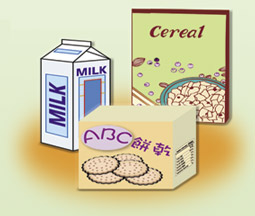 If you have been following the news lately, you should have noticed that the labelling scheme on nutrition information has again become a topical issue. In April, the Government reported to the Legislative Council Panel on Food Safety and Environmental Hygiene on the results of the public consultation exercise as well as the Regulatory Impact Assessment in respect of the scheme. A revised proposal was put forward at the panel meeting (see Annex). The Government invited different sectors to attend the Panel meeting in May to express their views. Here is an account of the latest developments.
If you have been following the news lately, you should have noticed that the labelling scheme on nutrition information has again become a topical issue. In April, the Government reported to the Legislative Council Panel on Food Safety and Environmental Hygiene on the results of the public consultation exercise as well as the Regulatory Impact Assessment in respect of the scheme. A revised proposal was put forward at the panel meeting (see Annex). The Government invited different sectors to attend the Panel meeting in May to express their views. Here is an account of the latest developments.
Throughout the consultation period which started in 2003 until the recent formulation of a revised proposal, the views collected generally indicated that most people supported the Government's implementation of a labelling scheme on nutrition information to promote public health. However, opinions were divided on the contents and details of the scheme.
Views from Different Sectors
Views on the scheme generally fell into two groups:
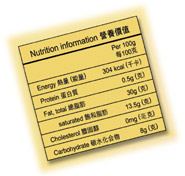 Views from the trade mainly include (1) to implement Phase I of the scheme only, that is, to require nutrition labelling for *prepackaged foods with nutrient-related claims; (2) to require labelling of nutrients which are more essential (i.e. energy plus 3 core nutrients including protein, carbohydrate and total fat) or to accept source countries' requirements for nutrition labelling; and (3) to extend the grace period.
Views from the trade mainly include (1) to implement Phase I of the scheme only, that is, to require nutrition labelling for *prepackaged foods with nutrient-related claims; (2) to require labelling of nutrients which are more essential (i.e. energy plus 3 core nutrients including protein, carbohydrate and total fat) or to accept source countries' requirements for nutrition labelling; and (3) to extend the grace period.
Views from the general public, dietitians and the health care sector mainly include (1) to label more nutrients, especially potassium and trans fat; and (2) to expedite the implementation of the scheme by shortening the grace period and/or combining the two phases into one, i.e. to implement the scheme in one go.
The International and Local Scenes
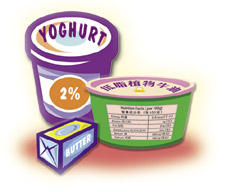 Objectively speaking, introduction of a nutrition labelling scheme has become a global trend. Nine countries have implemented or will enforce mandatory nutrition labelling scheme in full. They are the USA, Canada, Australia, New Zealand, Brazil, Israel, Argentina, Paraguay and Uruguay. Four countries/areas, namely Malaysia, Thailand, South Korea and Taiwan, require mandatory labelling for specific types of prepackaged foods, while 29 countries, including countries of the European Union, Japan, Singapore, the Philippines, Indonesia, Mexico, Chile and South Africa, have introduced legislation to require nutrition labelling for prepackaged foods with nutrient-related claims. Not only are developed countries implementing nutrition labelling scheme, more and more developing countries are doing so as they have come to recognise its importance in enhancing public health. In this regard, Hong Kong is certainly lagging behind many countries and areas of the world.
Objectively speaking, introduction of a nutrition labelling scheme has become a global trend. Nine countries have implemented or will enforce mandatory nutrition labelling scheme in full. They are the USA, Canada, Australia, New Zealand, Brazil, Israel, Argentina, Paraguay and Uruguay. Four countries/areas, namely Malaysia, Thailand, South Korea and Taiwan, require mandatory labelling for specific types of prepackaged foods, while 29 countries, including countries of the European Union, Japan, Singapore, the Philippines, Indonesia, Mexico, Chile and South Africa, have introduced legislation to require nutrition labelling for prepackaged foods with nutrient-related claims. Not only are developed countries implementing nutrition labelling scheme, more and more developing countries are doing so as they have come to recognise its importance in enhancing public health. In this regard, Hong Kong is certainly lagging behind many countries and areas of the world.
What is the local situation in respect of nutrition labelling for prepackaged foods? According to local market surveys commissioned by FEHD in 2001 and 2004, there was a marked increase in the proportion of prepackaged foods with nutrition labels and/or nutrition claims (those with nutrition labels rose from 42% to 50% while those carry nutrition claims rose from 19% to 28%). Increasing prevalence of nutrition labelling has to a certain extent reflected the importance attached by the trade and the market demand. The Government and the consumers, without doubt, welcome the growing trend in nutrition labelling. But currently, different forms of nutrition labelling are found in the local market, which vary in their contents, expression and formats, have caused confusion to consumers and make it difficult for them to compare the nutrient contents among different products. Besides, some nutrition information on the labels fails to meet the need of consumers, and some labels even carry false information.
A public opinion survey on nutrition labelling conducted in 2004 found that 95% of the respondents supported introducing regulatory control on nutrition labelling; 87% considered nutrition information important; 81% indicated that if all prepackaged foods would be labelled with nutrition information, they would use such information; 95% supported standardization of format of nutrition labels. After taking into account the overall savings in health care and the possible slight increase in the price of some products, 89% of the respondents still supported the implementation of a labelling scheme on nutrition information. Consumers' views on the scheme showed that they need accurate, standardised and detailed nutrition information to facilitate them in making food choices to stay healthy.
The Government's Role and the Revised Proposal
 Introduction of a new policy will always affect certain sector of the community and it is the Government's role to strike a balance among the interests of the sectors concerned to achieve a win-win situation as far as practicable. Our latest proposal aims at (1) reducing the costs incurred by the trade at the initial implementation of the new scheme to facilitate the trade in conforming to the requirements of the scheme. Based on the original proposal (i.e. to require labelling of energy plus 9 core nutrients), the Government now proposes that only energy plus 5 core nutrients are required to be listed at Phase I. Besides, the Government proposes to reduce the scope of regulatory control at Phase I to cover only prepackaged foods with nutrient-related claims. Our latest proposal also aims at (2) meeting the community's need in order to achieve the long-term goal of enhancing public health. In this connection, the revised proposal will expedite the implementation of a comprehensive nutrition labelling scheme by implementing Phase II two years after Phase I. The Government believes that the revised proposal will cut medical expenses, prevent loss of productivity and minimise early deaths, bringing considerable benefits to Hong Kong in the long run.
Introduction of a new policy will always affect certain sector of the community and it is the Government's role to strike a balance among the interests of the sectors concerned to achieve a win-win situation as far as practicable. Our latest proposal aims at (1) reducing the costs incurred by the trade at the initial implementation of the new scheme to facilitate the trade in conforming to the requirements of the scheme. Based on the original proposal (i.e. to require labelling of energy plus 9 core nutrients), the Government now proposes that only energy plus 5 core nutrients are required to be listed at Phase I. Besides, the Government proposes to reduce the scope of regulatory control at Phase I to cover only prepackaged foods with nutrient-related claims. Our latest proposal also aims at (2) meeting the community's need in order to achieve the long-term goal of enhancing public health. In this connection, the revised proposal will expedite the implementation of a comprehensive nutrition labelling scheme by implementing Phase II two years after Phase I. The Government believes that the revised proposal will cut medical expenses, prevent loss of productivity and minimise early deaths, bringing considerable benefits to Hong Kong in the long run.
The Government will continue to discuss with the trade on the technicality of implementing the scheme and enhance public education on nutrition labelling. For more information about the latest proposal and nutrition labelling, please visit the following websites:
http://www.legco.gov.hk/yr04-05/english/panels/fseh/papers/fe0415cb2-1230-05-e.pdf
http://www.fehd.gov.hk/english/pestcontrol/nutrient/index_nutrient.html
*"Prepackaged foods with nutrient-related claims" refers to foods which specifically mention certain nutrient contents on their packaging. Examples are "high calcium fresh milk" , "low sugar drinks" and "high fibre instant noodles" .
Annex: Main areas to be put under regulatory control based on the latest proposal on nutrition labelling (Revised in April 2005)
Having considered the local health situation, views collected during the consultation exercise and the results of the Regulatory Impact Assessment, the Government proposes to introduce a labelling scheme on nutrition information in Hong Kong in two phases and the main areas to be put under regulatory control are as follows:
Coverage
- Phase I - Labelling is required for prepackaged foods with nutrient-related claims
- Phase II - All prepackaged foods other than the exempted items
Nutrients required for labelling
- Phase I - Energy plus 5 core nutrients including protein, carbohydrate, total fat, saturated fat and sodium
- Phase II - Energy plus 9 core nutrients including protein, carbohydrate, total fat, saturated fat, sodium, cholesterol, sugars, dietary fibre and calcium
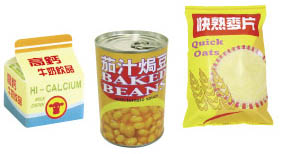
Grace period
- Phase I - Two years on enactment of the relevant legislation
- Phase II - Two years after the implementation of Phase I

Frequently Asked Questions about the Labelling Scheme on Nutrition Information:
1. Will nutrition labels have to be bilingual (i.e. Chinese and English)?
The proposed nutrition labelling scheme will be implemented by making reference to the requirements under the existing Foods and Drugs (Composition and Labelling) Regulations. If both English and Chinese are used in the labelling or marking of prepackaged food, the name, list of ingredients and nutrition information of the food should appear in both languages, otherwise labelling in either English or Chinese is allowed. However, the shelf-life of food must be set out in both English and Chinese (i.e. the labels must contain the expressions "best before此日期前最佳" or "use by此日期前食用" ).
2. Will the format of nutrition labels be regulated under the proposed scheme?
Under the proposal, nutrition labels must conform to a particular way for expressing nutrient content, the basic format being to express the energy or nutrient content in absolute amount in kilocalories/metric unit per 100g of food. In addition, nutrition labels should be displayed conspicuously on the package. As for the other requirements of the labelling format, such as the order of information to be displayed and font size, the Government will consult the trade at the technical meetings before finalizing the details. At present, there is no plan to regulate the format of the labels other than those expressing the nutrient contents.
3. Why are infant/follow-up formulae, foods for infant and young children, and other foods for special dietary uses excluded from the ambit of the labelling scheme on nutrition information?
The proposed scheme does not apply to these foods because the dietary requirements of infants, young children and those with special dietary needs are different from ordinary people. Besides, these foods are normally dealt with separately under the nutrition labelling regulations/guidelines of Codex Alimentarius Commission and overseas countries.
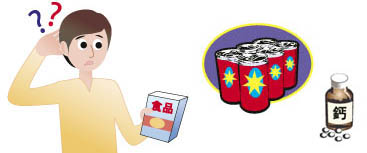 4. Will "soft drinks" be exempted from nutrition labelling?
4. Will "soft drinks" be exempted from nutrition labelling?
Products (i.e. "Coke" , "Cream Soda" etc.) commonly known as "soft drinks" usually contain ingredients such as sugar/sweetener and flavouring in addition to carbon dioxide. Such products are not on the exemption list.
5. Will the Government draw up any requirements for nutrient content claims?
The Government proposes to adopt the Table of Conditions for Nutrient Content Claims included in the Codex Guidelines for Use of Nutrition Claims. The trade will have to follow the conditions specified in the Table for making appropriate nutrient content claims.
6. Will the nutrition labelling scheme cover health foods and slimming foods?
Foods sold in Hong Kong (including health foods and slimming foods) are regulated by the respective laws, depending on the ingredients of the foods concerned. In general, products which do not contain Western drugs or Chinese medicine are regarded as food. The proposed nutrition labelling scheme will apply to all prepackaged foods.
7. What is the difference between a nutrient function claim and a health claim?
Nutrient function claim is a claim that describes the physiological role of a nutrient in growth, development and normal functions of the body (e.g. Product X is high in calcium. Calcium aids in the development of strong bones and teeth.). There is no mention of treatment or prevention of diseases in the claim. As for the health claims commonly seen, most of them relate to body functions, treatment or prevention of diseases or conditions in particular.
8. Will health claims be regulated under the proposed nutrition labelling scheme?
Since health claims contain information about physical health and disease prevention, etc., such claims will not be regulated under the proposed nutrition labelling scheme. However, noting that health claims have aroused public concern in recent years, the Health, Welfare and Food Bureau has conducted a consultation exercise on the regulation of health claims and submitted proposed legislative amendments to the Legislative Council. The amendments are now under deliberation by the Council.
II. Prohibited Dye in Food - Sudan I and Para Red
 In recent months, some food products around the world have to be recalled for containing industrial dyes Sudan I and Para Red. To learn more about the issue, I have done some research and let me put you in the picture.
In recent months, some food products around the world have to be recalled for containing industrial dyes Sudan I and Para Red. To learn more about the issue, I have done some research and let me put you in the picture.
As early as February 2005, some food products in the UK were found to contain Sudan I. Some local food manufacturers had used a chilli powder containing Sudan I to manufacture a sauce, which was then used as an ingredient in soup, sauce, potato chips, semi-products and instant food.
Sudan I is a red dye used for colouring solvents, waxes, petrol, shoe and floor polishes. According to the evaluation made by the International Agency for Research on Cancer, there is inadequate evidence on the carcinogenicity of Sudan I in humans.
On 21 April 2005, the UK Food Standards Agency found two dining kits for enchiladas and burritos of a certain brand contained a dye called Para Red. Subsequently, a chilli ingredient containing Para Red was found in 35 food products. Although the amount of the dye is unlikely to pose a threat to human health, it is prudent to act with caution.
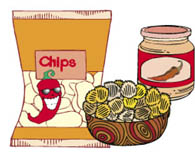 Para Red is a red printing ink. Both Para Red and Sudan I are industrial chemical dyes not permitted to be used in food colouring.
Para Red is a red printing ink. Both Para Red and Sudan I are industrial chemical dyes not permitted to be used in food colouring.
The two dyes involved in both food incidents will not cause immediate health hazards to human and there is no need to panic. The Colouring Matters in Food Regulations (Cap. 132H) of the Laws of Hong Kong has stipulated Sudan I and Para Red as non-permitted colouring matters. Testing for non-permitted colouring matters in food samples has already been included in the regular food surveillance programme conducted by the Food and Environmental Hygiene Department (FEHD). Food samples found in Hong Kong that contain Sudan I are mainly imported chilli products such as chilli powder and chilli oil. Major retailers in Hong Kong have stopped selling food products that may contain Sudan I or Para Red.
Advice to Consumers
When purchasing food, consumers should:
- purchase food from reputable sources;
- read carefully the information on the nutrition label of pre-packaged food such as the list of ingredients and the "best-before" date;
- not buy in case of doubt; and
- call FEHD's 24-hour Hotline at 2868 0000 or Citizen's Easy Link at 1823 for enquiries.
III. Maintaining Balanced Nutrition While Consuming Chinese Dim-sum
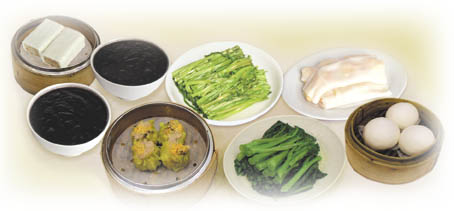
Food is the source of energy and nutrients. The human body needs energy to carry out daily activities while nutrients are vital for growth, tissue repair and staying healthy. Knowing the nutrient content of food facilitates the making of healthy food choices. To establish a database on nutrient composition of local food items, FEHD has been conducting nutrient analyses of various kinds on food ever since 2002. We have recently completed a study of the nutrient values of Chinese dim sum, the findings of which were released in mid-April this year.
A total of 75 common Chinese dim sum items were selected and samples were taken from different food premises for study. Chemical analyses were conducted to determine the content of energy and nine nutrients, namely, carbohydrate, protein, total fat, saturated fat, cholesterol, dietary fibre, sugar, sodium and calcium.
From the nutritional point of view, there is no good or bad food. To achieve a balanced diet, it is important to pay attention to the quantity and combination of the food consumed. The results of the study show that the total fat, saturated fat and sodium contents of some Chinese dim sum are quite high, whilst the calcium and dietary fibre contents are generally low. We should therefore choose different kinds of food to get the necessary nutrients and to reduce the risk of excessive intake of a particular nutrient.
To maintain a balanced diet, members of the public are advised to choose their food carefully when having Chinese dim sum meals. They should:
- choose Chinese dim sum that are rich in complex carbohydrate and low in fat, such as steamed rice-roll and steamed bun, as the staple food;
- consume about half plate of boiled vegetable per person (preferably without sauce) to get enough dietary fibre;
- consume steamed salty dim sum in moderate amount as some of them are high in fat and sodium;
- choose less pan-fried and deep-fried dim sum to avoid excessive intake of fat and energy; and
- avoid consuming the soup of rice-in-soup and noodles-in-soup.
As the calcium content of most Chinese dim sum is low, Chinese dim sum meals should be supplemented by other food items that are rich in calcium, such as dairy products, bean curd and green leafy vegetables. This ensures a sufficient intake of calcium and minimises the risk of osteoporosis. It is also advisable to consume sufficient amount of fruits and vegetables to get adequate amount of dietary fibre which in turn improves gastrointestinal health and reduces the risk of certain types of cancers.
Some reports have pointed to the "trimming" effect of Chinese tea, but there is still inadequate scientific evidence to prove that tea can effectively reduce the intake or accumulation of fat. To maintain a balanced diet, it is most important to watch the quantity and combination of food consumed.
For details of the study, please visit FEHD's website http://www.fehd.gov.hk.
Food Safety Plan Corner
Natural Toxins in Vegetables and Fruits
Recent food poisoning cases in the Mainland suspected to be related to natural toxins in green beans have aroused much public concern. In fact, many plants (including some common vegetables and fruits) contain natural toxins to protect themselves against pests and predators. Nevertheless, careful selection and preparation of these foods can minimize the risk of food poisoning.
What are the vegetables and fruits that contain natural toxins?
Natural toxins are present in certain beans, cassavas, bamboo shoots, fruit seeds and stones, fresh Jin Zhen, potatoes, etc.
| 1. Beans, such as green beans, red kidney beans and white kidney beans of the Phaseolus vulgaris species, contain a toxin known as phytohaemagglutinin. Consumption of these raw or undercooked beans may cause food poisoning with symptoms like nausea, vomiting and diarrhea within one to three hours. Research results have shown that heating of these beans to 80°C not only fails to destroy the phytohaemagglutinin but may even increase the toxicity. For safe consumption, soak the beans thoroughly and cook them well at boiling temperature to have the toxic substance destroyed. | 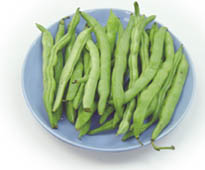 |
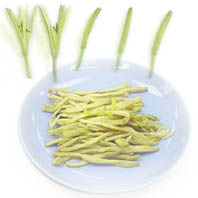 |
2. Fresh Jin Zhen - It is the bud of a kind of lily harvested before blossoming. The flowers and roots of the plant contain a toxin known as colchicines. Consumption of fresh Jin Zhen that has not been well soaked in water and thoroughly cooked may result in food poisoning with symptoms of gastrointestinal discomfort like abdominal pain, vomiting and diarrhea. Commercially processed Jin Zhen and dried Jin Zhen are safe to eat as the colchicines have been destroyed during processing. |
3. Potatoes - Potatoes contain toxic glycoalkaloids, but the levels are usually too low to have any adverse effects on human upon consumption. However, potatoes that show signs of greening, sprouting, damage or rotting contain high level of glycoalkaloids, the majority of which are present in the green area, in the skin, or right below the skin. Potatoes with high levels of glycoalkaloids have a bitter taste. Symptoms of poisoning include a burning sensation in the mouth, severe stomach ache, nausea and vomiting. Cooking cannot destroy glycoalkaloids and it is better to avoid eating potatoes that show signs of greening, sprouting, damage or rotting.
4. Cassavas and bamboo shoots - The root of cassava plants and fresh bamboo shoots contain cyanogenic glycoside. The bitter type of cassavas contains more toxin than the sweet ones. Ingestion of raw or undercooked cassavas or bamboo shoots will allow the cyanogenic glycoside to transform into toxic hydrogen cyanides in human body and result in food poisoning. Symptoms of hydrogen cyanide poisoning, which may occur within a few minutes, include constriction of the throat, nausea, vomiting, headache and even death in severe cases.
5. Fruit seeds and stones - These refer to seeds or stones (the large hard parts at the centre of some fruits) of apples, pears, apricots, plums, prunes, peaches, cherries, etc. The pulp of these fruits is non-toxic, but the seeds and stones (such as bitter apricot seeds) contain cyanogenic glycoside. Chewing these fresh stones or seeds will transform the cyanogenic glycosides into toxic hydrogen cyanides. Young children may be poisoned by hydrogen cyanides by ingesting only a few seeds or stones. Symptoms of poisoning are the same as those caused by cassavas and bamboo shoots.
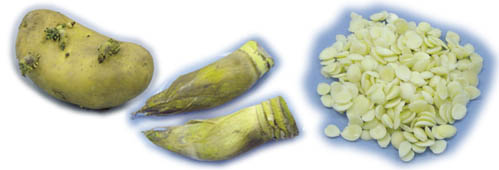
How to Reduce the Risk of Food Poisoning?
Selection:
- Purchase food from reputable sources. Do not patronize illegal hawkers.
- Do not purchase or consume potatoes that show signs of greening, sprouting, damage or rotting.
Preparation and Consumption:
- Do not eat vegetables and fruits raw if they should normally be consumed cooked. Cook thoroughly before consumption.
- Soak beans such as green beans, red kidney beans and white kidney beans thoroughly in water and cook them well at boiling temperature. Slice fresh cassavas and bamboo shoots and cook them thoroughly as well.
- Do not use raw or undercooked green beans, red kidney beans or white kidney beans for salad since even a few undercooked beans can cause food poisoning.
- Soak fresh Jin Zhen well in water and cook thoroughly.
- Store potatoes in shade, cool and dry place. Do not consume potatoes that show signs of greening, sprouting, damage or rotting. Discard them instead.
- Do not eat the seeds or stones of fruits like apples, pears, apricots, plums, prunes, peaches, cherries etc.
- Cook bitter apricot seeds thoroughly and consume in moderation.
Follow the above tips, have sufficient fruits and vegetables to maintain a balanced diet and stay healthy.
Activity Highlights
Food Safety Day 2005
"Food Temperature Control" cum "Signing of Food Safety Charter"

To promote food safety among the public and the trade, the Food and Environmental Hygiene Department (FEHD) and Radio Television Hong Kong (RTHK) jointly organize Food Safety Day 2005 - "Food Temperature Control" cum "Signing of Food Safety Charter" featuring performances, game booths and exhibition with a view to:
- arouse the awareness of the public and food trade about food safety;
- enhance the knowledge and skills of the public and food trade on proper temperature control to prevent food borne diseases;
- promote importance of the tripartite collaboration among the Government, food trade and public to ensure food safety;
- solicit the support of major stakeholders in upholding food safety.
Members of the trade and the public are welcome to the activity.
Details
Date: 24 July 2005 (Sunday)
Time: 3 to 5 p.m.
Venue: Plaza Hollywood, Diamond Hill, Kowloon
Organizers: FEHD, RTHK
Guests: Legislative Councillors, trade representatives, celebrities and pop singers.
Features: pop singers' performance, game booths and exhibition